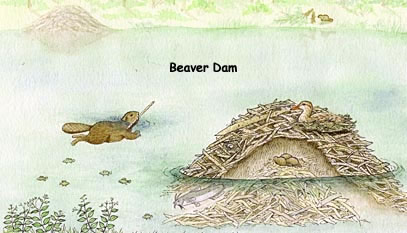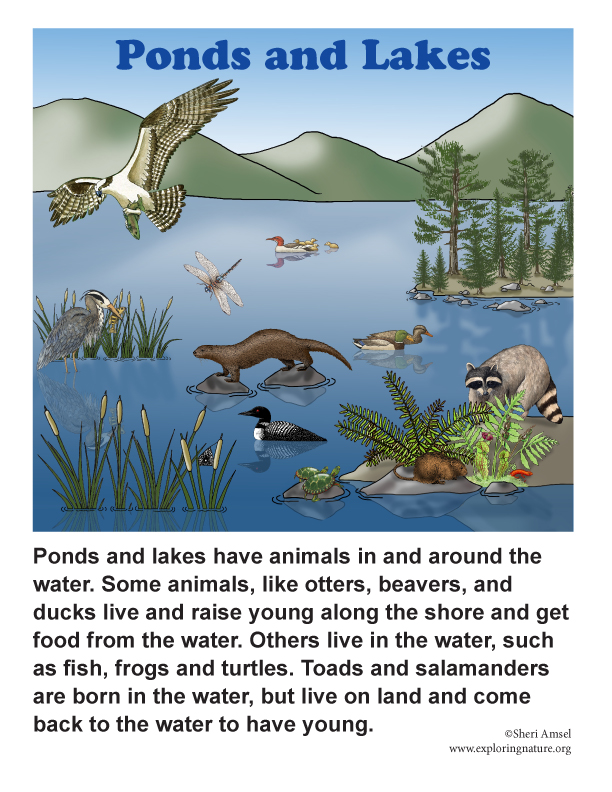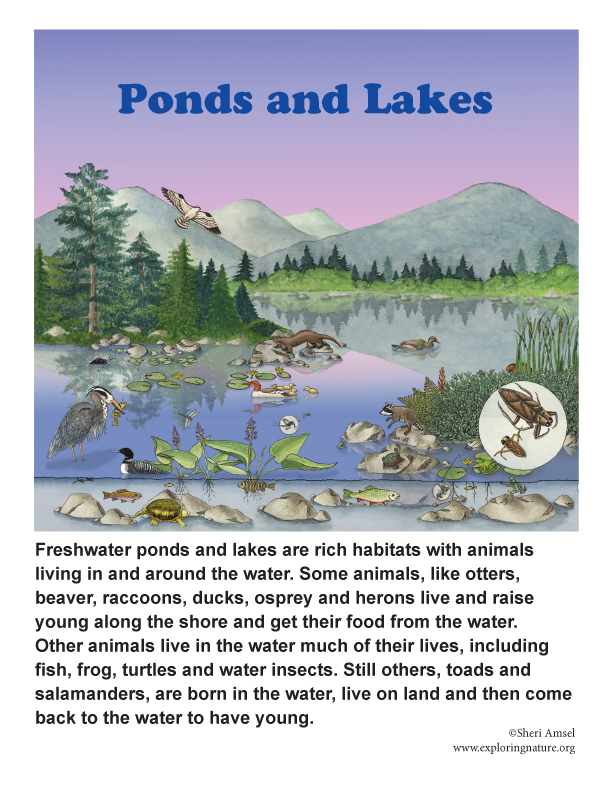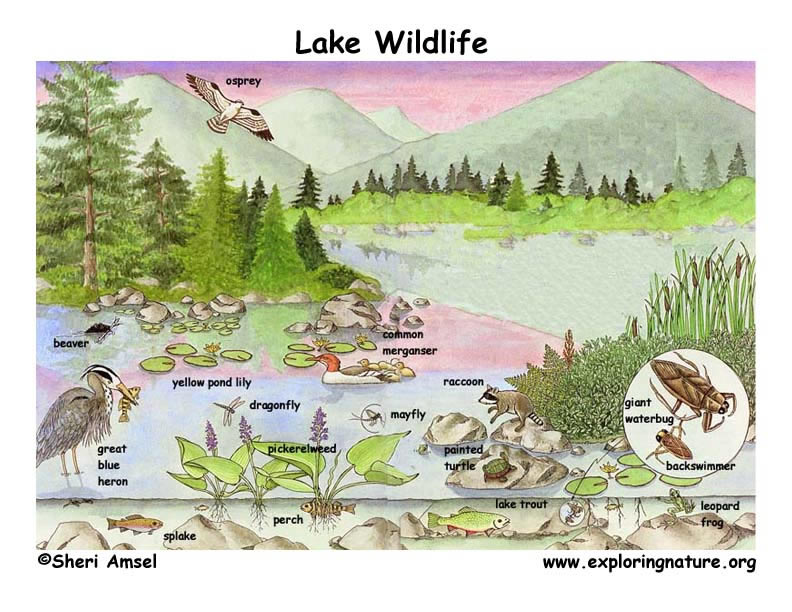

Ponds and lakes are found all over the world. They may even form in deserts after a rain for a short time.
Along the shore of a lake or pond, animals often live in and out of the water.
Amphibians – toads, salamanders and newts may live on land a lot of their lives, but go back to the water to mate and lay eggs. Toads live on land, but go to the water to mate and lay eggs. They are not fast running away from predators, but their lumpy skin oozes a toxin that makes them poisonous. They don't, however, cause warts. A toad is a helpful friend to have around the yard. They have a pleasant song and eat garden pests.
Reptiles, like painted turtles and snapping turtles, spend most of their lives in the water but come out on the land to lay their eggs (or to warm in the sun). Turtles, like many reptiles, do not care for their young. They lay eggs in the sand and return to the water. When the eggs hatch, the baby turtles find their own way to the water. They hatch at night, so the dark can protect them from predators. The moonlight shining on the water is like a beacon to the baby turtles. The snapping turtle can lay up to 80 ping-pong-ball-sized eggs in its sandy nest. They hatch in 60 days or they over-winter to hatch the next summer. Though snapping turtles move slowly, they can snap a broom handle with their powerful bite. They have long, flexible necks so be careful not to get too close.
Herons, osprey, and mergansers are birds that all eat fish, so must make their living near a body of water. Osprey are great fishermen. They hunt with their sharp talons. They can go all the way under water when diving for a fish. They build a large nest high on the tops of dead trees or even old power poles and stay in the north only while the water is open for fishing. When the lakes freeze, they go south. Great blue herons are often overlooked by people and prey. But when they move, they are fast, darting their long necks down to capture a fish or frog. They stay near lakes and ponds all summer, flying south when the waterways start to freeze.
Many insects spend their early growing stages in the water and then hatch out as adults to fly away and mate. These include the dragonfly, mayfly, dobsonfly, and damselfly. Other insects – the giant water bug, backswimmer, water strider and water boatman – stay in the water their whole lives.
Even the beaver, a land mammal, is so tied to the water that its body has special adaptations for life in it, like webbed back feet, a rudder-shaped tail and a thin membrane over their eyes that acts like swim goggles for traveling in water. They even have a plug that blocks their throat, so they can carry sticks through the water without drowning. Another mammal common around lakes and ponds is the mink. Mink live along the shoreline and are good swimmers. They hunt small mammals, frogs, and fish and will even kill a muskrat and then take over their den. They are active at night or in the dawn, so are rarely seen by people.
Many plants make their living in and along side ponds and lakes. Cattails and pickerelweed root in the bottom of lakes and ponds and grow right out of the water. Pond lilies lie on the surface of the water, their roots stretching down into the soil beneath. The shoreline can often be lined by ferns, blueberry bushes, horsetails, alders, and moss-covered rocks. Balsam fir, spruce, paper birch and white pine all do well near the water's edge.
_____________________________________________________________________________________________________________
Related Activity:
Lake Coloring Page
Related Visual Aid:
Lakeside Poster
_____________________________________________________________________________________________________________
When you research information you must cite the reference. Citing for websites is different from citing from books, magazines and periodicals. The style of citing shown here is from the MLA Style Citations (Modern Language Association).
When citing a WEBSITE the general format is as follows.
Author Last Name, First Name(s). "Title: Subtitle of Part of Web Page, if appropriate." Title: Subtitle: Section of Page if appropriate. Sponsoring/Publishing Agency, If Given. Additional significant descriptive information. Date of Electronic Publication or other Date, such as Last Updated. Day Month Year of access < URL >.
Amsel, Sheri. "Northern Ponds & Lakes - The Shoreline" Exploring Nature Educational Resource ©2005-2024. December 13, 2024
< http://www.exploringnature.org/db/view/Northern-Ponds-and-Lakes-The-Shoreline >



